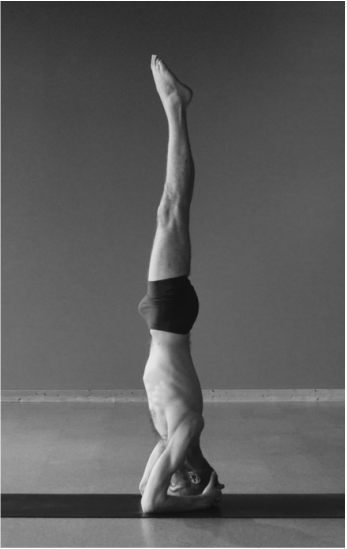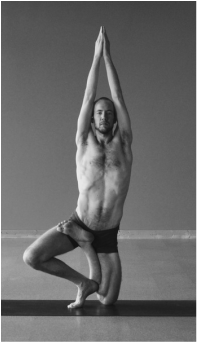|
As I meditate, I am occasionally distracted by sounds or vibrations. These things happen outside of my body and are picked up by my senses. My senses then draw my mind outward, seeking understanding of what is going on around me. As I deepen my practice it is important to become aware of my senses and their tendency to draw my mind outward. Eventually they will come under control. This is the 5th limb of Patanjali's yoga: Sensory Control or Pratyahara. Without this control, mental concentration and meditation are impossible as they are constantly interrupted by distraction.
The very beginnings of Pratyahara can be done while practicing Postures (asana). You may notice that your eyes often wander around the room, moving quickly from one object to another. The first step of Sensory Control is to hold the eyes still in a Drishti gaze, which is simply focusing the eyes for awhile without moving them. You will notice both how difficult this can be and how quickly it quiets the mind. Each of the senses draws the mind outward in a slightly different way and therefore has a slightly different technique for its control. These practices have become an obsession for me lately, and I can feel my mind gradually turning inward. Mental Concentration and Meditation follow logically from this place! I will be leading a workshop about Sensory Control (Pratyahara) at Inner Fire Yoga on July 30.
0 Comments
EGO
We all begin with ego. We don't necessarily think that we are better than everyone else, but we are generally rooted in our own concept of reality. And, more significantly, we don't realize that we are rooted in and limited by our own conceptions. This is the first wall that begins to show cracks with earnest practice, study and humility. We realize that there are other versions of reality out there that are just as valid as ours. (Or just as invalid.) And we begin to see that "reality" is usually something we construct with our own minds; a fairy tale we tell ourselves to bring the comfort of structure. INSTRUCTION Once our ego is sufficiently weakened, we generally need guidance from someone who has experience in these realms. We have spent most of our lives with the unchallenged view that our reality was the only one, so we have little experience with any other worldview. This is where a teacher comes in handy. We seek (and hopefully find) someone who has walked the path before and who can effectively communicate how to traverse the new mental terrain. FAITH Faith, as I am growing to see it, is not a belief but rather an acceptance of our lack of control. In this way, faith is the opposite of the ego. We build our egos and our ego-centric worldview specifically to protect us from our powerlessness. When our ego crumbles and we gain familiarity with the limitations and capabilities of our consciousness, we exist in a mystical state that is almost incomprehensible to the logical human brain. This state, where we are unanchored by the stable but rigid constructs of our own egos, is faith. Faith takes courage, especially at first. It is uncomfortable to our logical minds, this surrendering and seeking to comprehend our true powerlessness and role in the world. "All physical yoga techniques, including asana, are not designed to build or beautify the body or increase self-worth through proficiency in asana: their sole purpose is to prepare for meditation, and meditation is the technique to realize the Divine."
"Similarly, health is not the purpose of asana but is a by-product of being in harmony with cosmic forces, and that harmony supports and enables realization of the Divine." "While today on the one hand we face the problem of meditators who do not adequately prepare the body for meditation, on the other hand we have Hatha yogis who get stuck in the meaningless drudgery of mere physical yoga. If the yogi does not go beyond the practice of posture and breath work, and does not graduate to and include formal meditation, then Hatha Yoga is not what it purports to be. It is then mere body-building, body-beautifying and gymnastics. There is nothing wrong with those, as long as the label clearly states that we are doing only that. The problem with today's physical yoga is that it pretends to be more. And it is so only if it merges into the mental and spiritual disciplines of yoga." - From Yoga Meditation by Gregor Maehle. I just finished reading Gregor Maehle's new book Samadhi. In it he describes the eighth and final limb of Ashtanga Yoga.
It is becoming clearer to me that asana (postures) are a small part of yoga. They are certainly not its goal. They serve the vital purposes of bringing health to the body, allowing us to sit for long periods of time in stillness, and strengthening the body to tolerate the intense energetic effects of Kundalini meditation and samadhi. Yoga directs us toward understanding the nature of the mind and of consciousness. The 8 samadhis allow us to experience them firsthand instead of simply thinking about them theoretically. As a yoga teacher in the USA, my teachings are focused around asana. I think this needs to change. When we come to our practice each day, it is easy to bring expectations and baggage. What has this practice meant to me in the past? What was I capable of yesterday or last year? What do I expect my performance to be today? This is especially true if we do the same or similar practice each day.
While it is generally desire that brings us to our practice - the desire for fitness, stress relief, spirituality or something else - once we arrive and begin practicing our postures, breathing or meditation all desire and expectation should be discarded. The practice becomes immediate, with complete mental presence in the moment. There is no future and no past, no expectations and no baggage. Only right now, only our body and breath and mind right now.
It is not strength in the muscles
Or flexibility in the joints Or standing on one leg It is not balancing upside down Or holding the breath Stillness Awareness of every fiber of the body Every impulse of the nerves Every beat of the heart Every twitch of breeze and breath And stillness The goal is to feel and control
Each element of the body and mind. Each muscle contracts or relaxes intentionally. Each breath enters and exits on purpose. Each thought... the thoughts are few and far between, Focused on stillness and awareness. "Yoga is said to be the union of the individual self and the supreme self (divine)... These are the limbs: yama, niyama, asana, pranayama, pratyahara, dharana, dhyana, and samadhi. Yama and niyama are subdivided into ten types. Eight asanas are important and among them, three are the most important. Dharana is said to be of five types. Dhyana is of six types; among them, three are said to be more important. Samadhi is one, but some think it to be of many divisions."
From the Yoga Yajnavalkya. Thinking about a still mind
Is like talking about being quiet. |
This journal honors my ongoing experience with the practice, study and teaching of yoga.
My FavoritesPopular Posts1) Sridaiva Yoga: Good Intention But Imbalanced
2) Understanding Chair Posture 2) Why I Don't Use Sanskrit or Say Namaste 3) The Meaningless Drudgery of Physical Yoga 5) Beyond Bikram: Why This Is a Great Time For Ghosh Yoga Categories
All
Archives
November 2017
|



 RSS Feed
RSS Feed